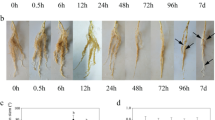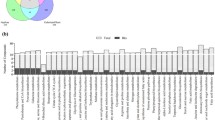Abstract
Imazethapyr is a widely used imidazolinone herbicide worldwide, and its potential adverse effects on non-target plants have raised concerns. Understanding the mechanisms of imazethapyr phytotoxicity is crucial for its agro-ecological risk assessment. Here, the comprehensive molecular responses and metabolic alterations of Arabidopsis in response to imazethapyr were investigated. Our results showed that root exposure to imazethapyr inhibited shoot growth, reduced chlorophyll contents, induced photoinhibition and decreased photosynthetic activity. By non-target metabolomic analysis, we identified 75 metabolites that were significantly changed after imazethapyr exposure, and they are mainly enriched in carbohydrate, lipid and amino acid metabolism. Transcriptomic analysis confirmed that imazethapyr significantly downregulated the genes involved in photosynthetic electron transport and the carbon cycle. In detail, 48 genes in the photosynthetic lightreaction and 11 genes in Calvin cycle were downregulated. Additionally, the downregulation of genes related to electron transport in mitochondria provides strong evidence for imazethapyr inhibiting photosynthetic carbon fixation and cellular energy metabolism as one of mechanisms of toxicity. These results revealed the molecular and metabolic basis of imazethapyr toxicity on non-target plants, contributing to environmental risk assessment and mitigate negative impact of imazethapyr residues in agricultural soils.
Graphic Abstract








Similar content being viewed by others
Data Availability
The data generated or analyzed during this study are included in this published article and are available from the corresponding author upon reasonable request.
Abbreviations
- ROS:
-
Reactive oxygen species
- MS:
-
Murashige and Skoog
- BCF:
-
Bioconcentration factor
- KEGG:
-
Kyoto Encyclopedia of Genes and Genomes
- VIP:
-
Variable importance in projection
- PCA:
-
Principal component analysis;
- DEGs:
-
Differentially expressed genes
- GO:
-
Gene Ontology
- Fv/Fm:
-
Maximal photochemical efficiency
- NPQ:
-
Non-photochemical quenching
- Y (II):
-
Effective photochemical quantum yield of PSII
- Qp:
-
Photochemical quenching coefficient
- qN:
-
Non-photochemical chlorophyll fluorescence quenching
- Y(NO):
-
Non-regulated energy dissipation in PSII
References
Adams WW, Muller O, Cohu CM, Demmig-Adams B (2013) May photoinhibition be a consequence, rather than a cause, of limited plant productivity? Photosynth Res 117:31–44
Baker NR (2008) Chlorophyll fluorescence: a probe of photosynthesis in vivo. Annu Rev Plant Biol 59:89–113
Chang Q, Ji W, Lu Q, Xue J, Hua R, Wu X (2021) Bioavailability and toxicity of imazethapyr in maize plant estimated by four chemical extraction techniques in different soils. Sci Total Environ 801:149594
Chen Z, Chen H, Zou Y, Qiu J, Wen Y, Xu D (2015) Are nutrient stresses associated with enantioselectivity of the chiral herbicide imazethapyr in Arabidopsis thaliana? J Agric Food Chem 63(47):10209–10217
Cheong JJ, Do Choi Y (2003) Methyl jasmonate as a vital substance in plants. Trends Genet 19(7):409–413
Donnini S, Guidi L, Degl’Innocenti E, Zocchi G (2013) Image changes in chlorophyll fluorescence of cucumber leaves in response to iron deficiency and resupply. J Plant Nutr Soil Sci 176(5):734–742
Fassiano AV, March H, Santos M, Juárez ÁB, Ríos de Molina MDC (2022) Toxicological effects of active and inert ingredients of imazethapyr formulation Verosil® against Scenedesmus vacuolatus (Chlorophyta). Environ Sci Pollut Res 29:31384–31399
Filomeni G, Rotilio G, Ciriolo MR (2002) Cell signaling and the glutathione redox system. Biochem Pharmacol 64(5–6):1057–1064
Fuerst EP, Norman MA (1991) Interactions of herbicides with photosynthetic electron transport. Weed Sci 39(3):458–464
Gururani MA, Venkatesh J, Tran LSP (2015) Regulation of photosynthesis during abiotic stress-induced photoinhibition. Mol Plant 8(9):1304–1320
Han RC, Rasheed A, Wang YP, Wu ZF, Tang SQ, Shi QH, Wu ZM (2018) Silencing of OsXDH reveals the role of purine metabolism in dark tolerance in rice seedlings. J Integr Agric 17(8):1736–1744
Huang J, Bao M, Li J, Chen H, Xu D, Chen Z, Wen Y (2022) Enantioselective response of wheat seedlings to imazethapyr: from the perspective of Fe and the secondary metabolite DIMBOA. J Agric Food Chem 70(18):5516–5525
Jourdan SW, Majek BA, Ayeni AO (1998) Imazethapyr bioactivity and movement in soil. Weed Sci 46(5):608–613
Lam HM, Coschigano KT, Oliveira IC, Melo-Oliveira R, Coruzzi GM (1996) The molecular-genetics of nitrogen assimilation into amino acids in higher plants. Annu Rev Plant Biol 47(1):569–593
Li W, Fan D, Luan Y (2008) Current situation, problems and solutions of ethametsulfuron, chlorimuron-ethyl and imazethapyr. Agrochemicals 47(11):781–789
Li Y, Zhang N, Xu J, Liu L, Cao X, Lin X, Sun C (2023) Imazethapyr disrupts plant phosphorus homeostasis and acquisition strategies. J Hazard Mater 460:132317
Lootens P, Devacht S, Baert J, Van Waes J, Van Bockstaele E, Roldán-Ruiz I (2011) Evaluation of cold stress of young industrial chicory (Cichorium intybus L.) by chlorophyll a fluorescence imaging II Dark Relaxation Kinetics. Photosynthetica 49:185–194
Ma QQ, Wang W, Li YH, Li DQ, Zou Q (2006) Alleviation of photoinhibition in drought-stressed wheat (Triticum aestivum) by foliar-applied glycinebetaine. J Plant Physiol 163(2):165–175
Magdaleno A, Peralta Gavensky M, Fassiano AV, Ríos de Molina MC, Santos M, March H, Juárez ÁB (2015) Phytotoxicity and genotoxicity assessment of imazethapyr herbicide using a battery of bioassays. Environ Sci Pollut Res 22:19194–19202
Møller IM (2001) Plant mitochondria and oxidative stress: electron transport, NADPH turnover, and metabolism of reactive oxygen species. Annu Rev Plant Biol 52(1):561–591
Moreland DE (1980) Mechanisms of action of herbicides. Annu Rev Plant Physiol 31(1):597–638
Noctor G, Foyer CH (1998) Ascorbate and glutathione: keeping active oxygen under control. Annu Rev Plant Biol 49(1):249–279
Perucci P, Scarponi L (1994) Effects of the herbicide imazethapyr on soil microbial biomass and various soil enzyme activities. Biol Fertil Soils 17(3):237–240
Petit AN, Fontaine F, Vatsa P, Clément C, Vaillant-Gaveau N (2012) Fungicide impacts on photosynthesis in crop plants. Photosynth Res 111:315–326
Prat O, Degli-Esposti D (2019) New challenges: omics technologies in ecotoxicology. In: Ecotoxicology. Elsevier, pp 181–208
Pucciariello C, Perata P (2017) New insights into reactive oxygen species and nitric oxide signaling under low oxygen in plants. Plant Cell Environ 40(4):473–482
Qian H, Hu H, Mao Y, Ma J, Zhang A, Liu W, Fu Z (2009) Enantioselective phytotoxicity of the herbicide imazethapyr in rice. Chemosphere 76(7):885–892
Qian H, Lu T, Peng X, Han X, Fu Z, Liu W (2011a) Enantioselective phytotoxicity of the herbicide imazethapyr on the response of the antioxidant system and starch metabolism in Arabidopsis thaliana. PLoS ONE 6(5):e19451
Qian H, Wang R, Hu H, Lu T, Chen X, Ye H, Liu W, Fu Z (2011b) Enantioselective phytotoxicity of the herbicide imazethapyr and its effect on rice physiology and gene transcription. Environ Sci Technol 45(16):7036–7043
Qian H, Han X, Zhang Q, Sun Z, Sun L, Fu Z (2013) Imazethapyr enantioselectively affects chlorophyll synthesis and photosynthesis in Arabidopsis thaliana. J Agric Food Chem 61(6):1172–1178
Qian H, Han X, Peng X, Lu T, Liu W, Fu Z (2014) The circadian clock gene regulatory module enantioselectively mediates imazethapyr-induced early flowering in Arabidopsis thaliana. J Plant Physiol 171(5):92–98
Qian H, Li Y, Sun C, Lavoie M, Xie J, Bai X, Fu Z (2015) Trace concentrations of imazethapyr (IM) affect floral organs development and reproduction in Arabidopsis thaliana: IM-induced inhibition of key genes regulating anther and pollen biosynthesis. Ecotoxicology 24:163–171
Shakir SK, Kanwal M, Murad W, Rehman Z, Rehman S, Daud MK, Azizullah A (2016) Effect of some commonly used pesticides on seed germination, biomass production and photosynthetic pigments in tomato (Lycopersicon esculentum). Ecotoxicology 25:329–341
Sharma A, Kumar V, Shahzad B, Ramakrishnan M, Singh Sidhu GP, Bali AS, Zheng B (2020) Photosynthetic response of plants under different abiotic stresses: a review. J Plant Growth Regul 39:509–531
Shin YK, Bhandari SR, Lee JG (2021) Monitoring of salinity, temperature, and drought stress in grafted watermelon seedlings using chlorophyll fluorescence. Front Plant Sci 12:786309
Singh BK, Kuhad RC, Singh A, Lal R, Tripathi KK (1999) Biochemical and molecular basis of pesticide degradation by microorganisms. Crit Rev Biotechnol 19(3):197–225
Smirnoff N, Wheeler GL (2000) Ascorbic acid in plants: biosynthesis and function. Crit Rev Plant Sci 19(4):267–290
Sun C, Dudley S, Trumble J, Gan J (2018) Pharmaceutical and personal care products-induced stress symptoms and detoxification mechanisms in cucumber plants. Environ Pollut 234:39–47
Thimm O, Bläsing O, Gibon Y, Nagel A, Meyer S, Krüger P, Stitt M (2004) MAPMAN: a user-driven tool to display genomics data sets onto diagrams of metabolic pathways and other biological processes. Plant J 37(6):914–939
Walker KA, Givan CV, Keys AJ (1984) Glutamic acid metabolism and the photorespiratory nitrogen cycle in wheat leaves: metabolic consequences of elevated ammonia concentrations and of blocking ammonia assimilation. Plant Physiol 75(1):60–66
Watanabe S, Kounosu Y, Shimada H, Sakamoto A (2014) Arabidopsis xanthine dehydrogenase mutants defective in purine degradation show a compromised protective response to drought and oxidative stress. Plant Biotechnol 31(2):173–178
Wu J, Ge F, Zhu L, Liu N (2023) Potential toxic mechanisms of neonicotinoid insecticides in rice: Inhibiting auxin-mediated signal transduction. Environ Sci Technol 57(12):4852–4862
Yeo AR, Caporn SJM, Flowers TJ (1985) The effect of salinity upon photosynthesis in rice (Oryza sativa L.): gas exchange by individual leaves in relation to their salt content. J Exp Bot 36(8):1240–1248
Zabalza A, Gaston S, Sandalio LM, del Río LA, Royuela M (2007) Oxidative stress is not related to the mode of action of herbicides that inhibit acetolactate synthase. Environ Exp Bot 59(2):150–159
Zhang X, Liu N, Lu H, Zhu L (2022a) Molecular mechanism of organic pollutant-induced reduction of carbon fixation and biomass yield in Oryza sativa L. Environ Sci Technol 56(7):4162–4172
Zhang Y, Huang L, Liu L, Cao X, Sun C, Lin X (2022b) Metabolic disturbance in lettuce (Lactuca sativa) plants triggered by imidacloprid and fenvalerate. Sci Total Environ 802:149764
Zhou Q, Xu C, Zhang Y, Liu W (2009) Enantioselectivity in the phytotoxicity of herbicide imazethapyr. J Agric Food Chem 57(4):1624–1631
Funding
This work was supported by the National Key Research and Development Program of China (2023YFD1701302), the Natural Science Foundation of Zhejiang Province (LQ24C030003), and the National Natural Science Foundation of China (22006130).
Author information
Authors and Affiliations
Contributions
L Liu, N Zhang and Z Chen performed the experiment, analyzed the data and wrote the manuscript; C Sun, L Liu and Z Tian were involved in the discussion of the manuscript organization and revised the manuscript; L Liu, N Zhang, J Liu and Z Chen conceived the research plans and was involved in the discussion of the manuscript organization. All authors read and approved the final article.
Corresponding author
Ethics declarations
Ethical approval
Not applicable.
Consent to participate
Not applicable.
Consent for publication
Not applicable.
Competing interests
The authors declare no competing interests.
Additional information
Responsible Editor: Gangrong Shi
Publisher's Note
Springer Nature remains neutral with regard to jurisdictional claims in published maps and institutional affiliations.
Supplementary Information
Below is the link to the electronic supplementary material.
Rights and permissions
Springer Nature or its licensor (e.g. a society or other partner) holds exclusive rights to this article under a publishing agreement with the author(s) or other rightsholder(s); author self-archiving of the accepted manuscript version of this article is solely governed by the terms of such publishing agreement and applicable law.
About this article
Cite this article
Liu, L., Chen, Z., Zhang, N. et al. Transcriptomic and metabolomic analysis provides insight into imazethapyr toxicity to non-target plants. Environ Sci Pollut Res 31, 28368–28378 (2024). https://doi.org/10.1007/s11356-024-32967-x
Received:
Accepted:
Published:
Issue Date:
DOI: https://doi.org/10.1007/s11356-024-32967-x




